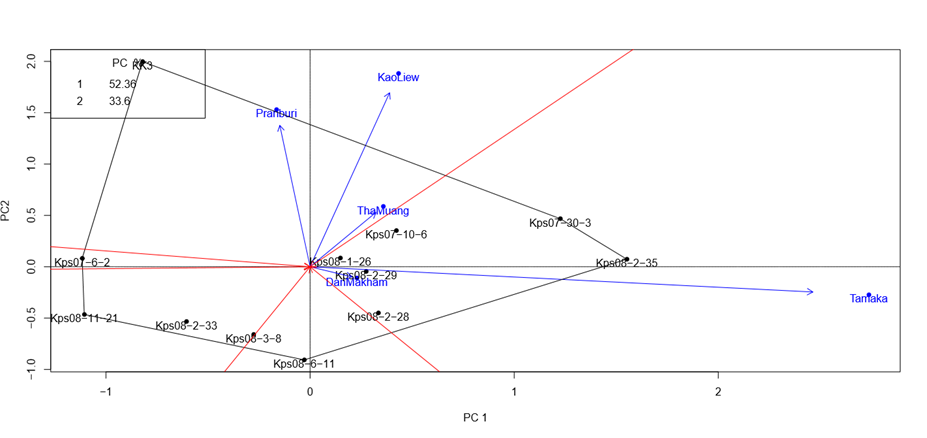การวิเคราะห์เสถียรภาพของอ้อยพันธุ์กำแพงแสน ชุดปี 2007 และ 2008 ด้วยวิธี GGE Biplot ในภาคกลาง | Stability Analysis of Kamphaeng Saen Sugarcane Variety Series 2007 and 2008 Using GGE Biplot Method in the Central Region
Main Article Content
Abstract
The purpose of the study was to use the GGE biplot method to assess the stability of cane yield, CCS and sugar yield, of 12 sugarcane varieties from 5 locations in the central region. The RCBD with 3 replications was used in each trail. The plot had 3 rows of 8 meters in length. The results revealed that the environmental factor in the central region had high effect on the CCS and sugar yield, higher than 40 pencent whereas the genetic factor had the lowest percentage. From the comparison the effect of the interaction between the enviroment and the genetic factor and the genetic factor, it was found that the cane yield had low effect while the CCS and the sugar yield had high effect, respectively.
The result of the stability analysis using the GGE biplot method to assess the stability of the cane yield characteristics, CCS and sugar yield, it was able to determine the suitable areas or the environment in the sugarcane growing area. Kamphaeng Saen 07-30-3 was found to be able to adapt in a variety of the environment that had good yield potential and good stability in the CCS and sugar yield and the Kamphaeng Saen 08-2-33 had good stability in the cane yield. In terms of the suitable trails in the central region for discrimination the outstanding sugarcane varieties were Kao Liew for the cane yield and sugar yield; and Tamaka for the CCS.
บทคัดย่อ
ได้ใช้ GGE biplot ในการประเมินเสถียรภาพลักษณะผลผลิตอ้อย ซีซีเอส และผลผลิตน้ำตาลในพันธุ์อ้อย 12 พันธุ์ จาก 5 สถานที่ในภาคกลาง แต่ละแปลงทดลองใช้แผนการทดลองแบบ RCBD มี 3 ซ้ำ แปลงย่อยมี 3 แถว ยาว 8 เมตร ผลการทดลองพบว่า ปัจจัยสภาพแวดล้อมในภาคกลางมีผลต่อความแปรปรวนของผลผลิตอ้อย ซีซีเอส และผลผลิตน้ำตาล สูงมากกว่า 40% โดยอิทธิพลต่อความแปรปรวนจากพันธุกรรมมีเปอร์เซ็นต์ต่ำสุด จากการเปรียบเทียบอิทธิพลของปฏิกิริยาสัมพันธ์ระหว่างสภาพแวดล้อมกับพันธุกรรมกับอิทธิพลของพันธุกรรม พบว่าผลผลิตอ้อยมีอิทธิพลของปฏิกิริยาสัมพันธ์ที่ต่ำ ในขณะที่ซีซีเอสและผลผลิตน้ำตาลมีค่าสูง ตามลำดับ ผลจากการวิเคราะห์เสถียรภาพโดยใช้วิธี GGE biplot ในการประเมินเสถียรภาพลักษณะผลผลิตอ้อย ซีซีเอส และผลผลิตน้ำตาล สามารถกำหนดพื้นที่หรือสภาพแวดล้อมที่เหมาะสมในพื้นที่ปลูกอ้อย สำหรับอ้อยพันธุ์กำแพงแสนสามารถปรับตัวได้กว้างในสภาพแวดล้อมต่างๆ
มีศักยภาพในการให้ผลผลิตที่ดีและมีเสถียรภาพที่ดี คือ พันธุ์กำแพงแสน 07-30-3 ในลักษณะซีซีเอสและผลผลิตน้ำตาล และพันธุ์กำแพงแสน 08-2-33 ในลักษณะผลผลิตอ้อย ส่วนแปลงทดสอบในภาคกลาง
ที่เหมาะสมสำหรับการแบ่งแยกพันธุ์ที่ดีเด่นในลักษณะต่างๆ คือ แปลงเก้าเลี้ยวในลักษณะผลผลิตอ้อยและผลผลิตน้ำตาล และแปลงท่ามะกาในลักษณะซีซีเอส
Downloads
Article Details
References
กิตติศักดิ์ ฉันทวุฒิพร. (2549). เสถียรภาพผลผลิตของคะน้า 10 สายพันธุ์. วิทยานิพนธ์ปริญญามหาบัณฑิต, มหาวิทยาลัยเกษตรศาสตร์, กรุงเทพฯ.
ชูศักดิ์ จอมพุก. (2551). สถิติ: การวางแผนการทดลองและการวิเคราะห์ข้อมูลในงานวิจัยด้านพืชไร่ด้วย R. กรุงเทพฯ: โรงพิมพ์สำนักส่งเสริมและฝึกอบรม มหาวิทยาลัยเกษตรศาสตร์.
ชูศักดิ์ จอมพุก. (2559). วิธีวิเคราะห์ทางพันธุศาสตร์ปริมาณในการปรับปรุงพันธุ์พืช. (น. 304-310). กรุงเทพฯ: นีโอดิจิตอล.
ธิศวรรณ บัวเฉียง และเรวัต เลิศฤทัยโยธิน. (2562). การประเมินเสถียรภาพของอ้อยพันธุ์กำแพงแสนชุดปี 2007 ในอ้อยตอ โดยการวิเคราะห์ GGE. วารสารวิทยาศาสตร์และเทคโนโลยี มหาวิทยาลัยเกษตรศาสตร์, 8(2), 1-14.
พลัง สุริหาร และกมล เลิศรัตน์. (2550). การทดสอบพันธุ์ข้าวโพดข้าวเหนียวหลายสภาพแวดล้อมในประเทศไทย. วารสารแก่นเกษตร, 35(4): 469-476.
ศุภนัส แสบงบาล. (2555). การประเมินเสถียรภาพของพันธุ์อ้อยกำแพงแสนโดยวิธี Eberhart และ Russe และวิธี AHMI และ GGE. วิทยานิพนธ์ปริญญามหาบัณฑิต, มหาวิทยาลัยเกษตรศาสตร์, กรุงเทพฯ.
สำนักงานคณะกรรมการอ้อยและน้ำตาล. (2562). รายงานการผลิต 2560/2562. สืบค้นเมื่อวันที่ 13 กันยายน 2563 สืบค้นจาก www.ocsb.go.th.
Balestre, M., de Souza, J. C., Von Pinho, R. G., de Oliveira, R. L., & Paes, J. M. V. (2009). Yield stability and adaptability of maize hybrids based on GGE biplot analysis characteristics. Crop Breeding & Applied Biotechnology, 9(3), 219-228.
Ferraro, D. O., Rivero, D. E., & Ghersa, C. M. (2009). An analysis of the factors that influence sugarcane yield in Northern Argentina using classification and regression trees. Field crops research, 112(2-3), 149-157.
Hunsigi, G. (1993). Production of Sugarcane. (p. 779). Amsterdam: Elsevier.
Kaya, Y., Akçura, M., & Taner, S. (2006). GGE-biplot analysis of multi-environment yield trials in bread wheat. Turkish Journal of Agriculture and Forestry, 30(5), 325-337.
Mndolwa, E. J., Msolla, S. N., Porch, T. G., & Miklas, P. N. (2019). GGE biplot analysis of yield stability for Andean dry bean accessions grown under different abiotic stress regimes in Tanzania. African Crop Science Journal, 27(3), 413-425.
Queme, J. L., Orozco, H., & Melgar, M. (2010). GGE biplot analysis used to evaluate cane yield of sugarcane (Saccharum spp.) cultivars across sites and crop cycles. In Proc. Int. Soc. Sugar Cane Technol (Vol. 27, pp. 1-7).
Venables, W.N., Smith, D.M., & The R Development Core Team. (2009). An Introduction to R. Retrieved February, 29, 2020 from http://www.R-project.org,.
Voltas, J., Lopez-Corcoles, H., & Borras, G. (2005). Use of biplot analysis and factorial regression for the investigation of superior genotypes in multi-environment trials. European Journal of Agronomy, 22(3), 309-324.
Yan, W., Hunt, L. A., Sheng, Q., & Szlavnics, Z. (2000). Cultivar evaluation and mega‐environment investigation based on the GGE biplot. Crop science, 40(3), 597-605.
Yan, W. (2001). GGEbiplot—A Windows application for graphical analysis of multienvironment trial data and other types of two‐way data. Agronomy journal, 93(5), 1111-1118.
Yan, W., & Tinker, N. A. (2005). An integrated biplot analysis system for displaying, interpreting, and exploring genotype× environment interaction. Crop Science, 45(3), 1004-1016.

